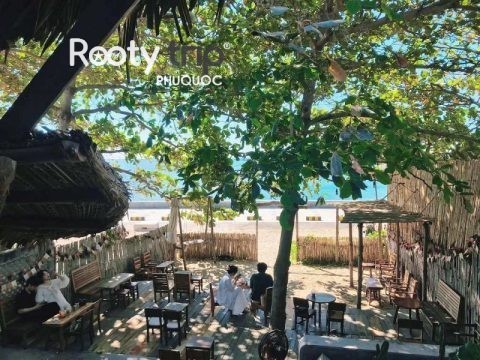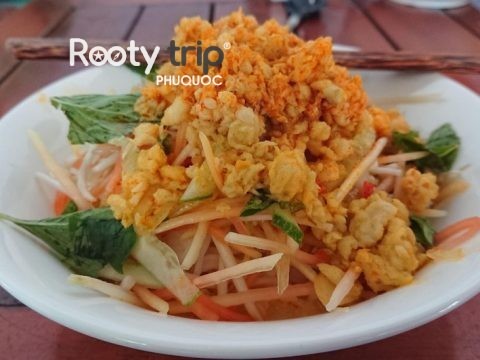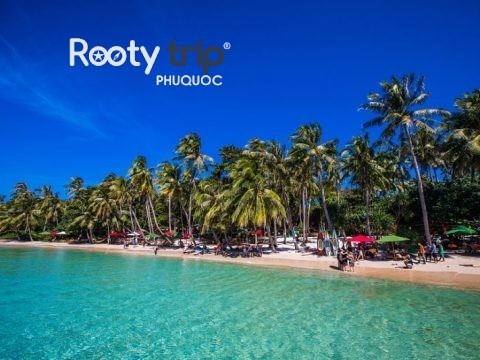Discover Dinh Cau Temple – Phu Quoc’s Spiritual Seaside Gem
09/05/2025Phu Quoc tourism offers a wide range of fascinating attractions that captivate visitors, and among them, Dinh Cau can be considered a prominent destination representing one of the island’s key spiritual tourism sites. So, who is worshipped at Dinh Cau Temple Phu Quoc? Where is it located? Let’s explore together with Rooty Trip!
Where is Dinh Cau Temple in Phu Quoc located?
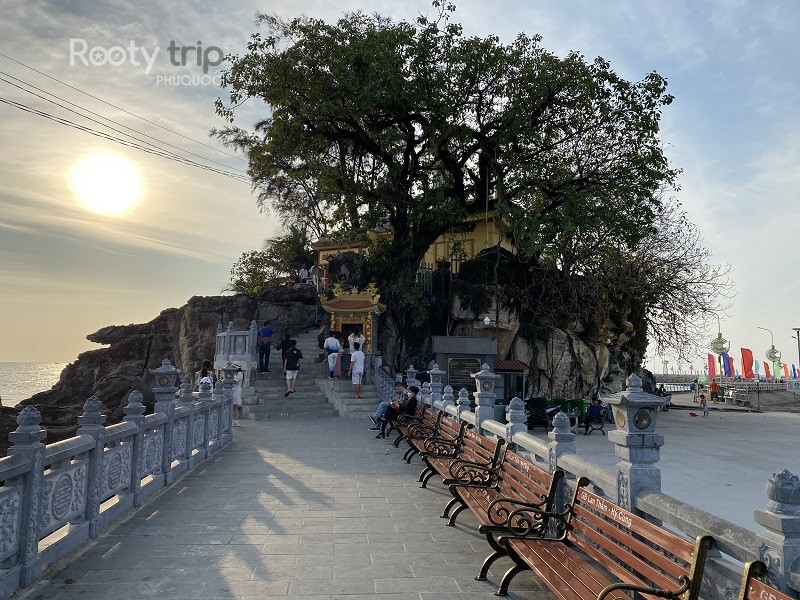
Location and role of Dinh Cau in Phu Quoc
Located on a natural rocky outcrop that juts out into the sea at the mouth of the Duong Dong River, Dinh Cau Temple sits in a prime location right in the heart of Duong Dong Town – the “heart” of Phu Quoc Island. This spot is not only easily accessible but is also believed to hold special feng shui significance, acting as a sacred “guardian gate” for fishermen before they head out to sea.
Dinh Cau is not just a famous tourist destination, but also a long-standing spiritual symbol for the local people. With its ancient architecture and its dramatic position perched atop a rock between the crashing waves and sea breezes, Dinh Cau leaves a lasting impression on anyone who visits for the first time. Many tourists come here to take in the stunning natural scenery, soak in the tranquil atmosphere, and witness one of the most beautiful sunsets on the island.
Cultural importance in local life
For the people of Phu Quoc – especially the fishing communities – Dinh Cau is more than just a temple; it is deeply tied to their faith and age-old folk traditions. Locals believe that the deities worshipped here will bless them with safe voyages, good weather, and abundant catches.
Every year, on the 15th and 16th days of the 10th lunar month, the Dinh Cau Festival is celebrated with solemn worship ceremonies, lion dances, traditional shadow puppet performances, and other vibrant cultural activities. This occasion serves as a time for the community to honor the deities, reinforce communal bonds, and continue preserving the beautiful cultural heritage passed down through generations.
History of Dinh Cau Temple
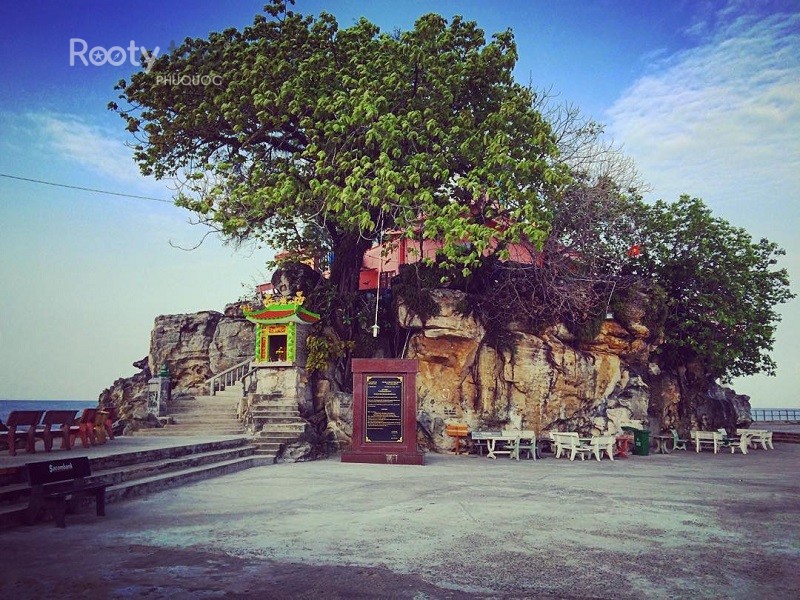
Dating back to the 17th century
Dinh Cau Temple is one of the oldest spiritual relics on Phu Quoc Island, with its origins tracing back to the 17th century, during the early days when Vietnamese settlers first arrived to cultivate and inhabit the island. At the time, with their lives closely tied to the dangerous open sea, the locals built a small shrine atop a rocky outcrop facing the ocean, to pray for safe and peaceful voyages.
Initially, it was just a simple, makeshift shrine, modestly constructed. Over time, due to the deep faith and devotion of the local people, Dinh Cau was gradually renovated and solidified. Today, it stands as not only a sacred site but also a must-visit destination for anyone traveling to Phu Quoc.
The legend behind Dinh Cau
The formation of Dinh Cau is surrounded by mystical legends that have been passed down through generations. One popular tale recounts that in the early days of village life, many fishermen suffered mysterious accidents at sea and never returned. One night, villagers dreamt of two boys appearing in their sleep, guiding them to build a shrine on a sacred rock to seek protection from the sea gods. Since then, the people began worshipping two guardian spirits: Cau Tai and Cau Quy, believed to be the protectors of the Phu Quoc seas.
The legend says that ever since the shrine was built, the fishermen have had smoother journeys and encountered fewer maritime accidents. This strengthened their spiritual beliefs and turned Dinh Cau into one of the most sacred places on the island.
Recognized as a provincial heritage site in 2012
Recognizing its cultural, historical, and spiritual significance, in 2012, Dinh Cau was officially recognized by the People’s Committee of An Giang Province as a provincial-level historical and cultural relic. This recognition not only affirms the temple’s long-standing role in the spiritual life of Phu Quoc’s residents but also marks an important milestone in promoting Dinh Cau as a destination of both local and international interest.
This status has also helped boost efforts in preservation, restoration, and cultural tourism, ensuring that Dinh Cau remains an irreplaceable part of Vietnam’s maritime heritage.
Architecture of Dinh Cau
Fusion of Vietnamese – Chinese architectural styles
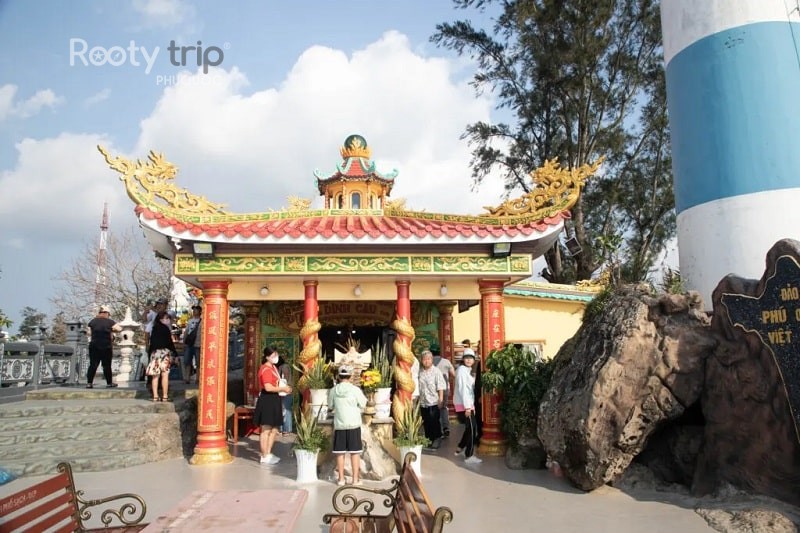
Dinh Cau captivates not only with its spiritual value but also with its unique architectural style, reflecting a harmonious blend of Vietnamese and Chinese cultural influences. The temple is built in the style of traditional Southern Vietnamese houses, featuring yin-yang tiled roofs, sturdy wooden pillars, and intricate decorative details. This architectural approach creates a sacred yet familiar atmosphere, embodying both simplicity and reverence.
Inside the temple lies a solemn space dedicated to Thien Hau Thanh Mau (the Heavenly Queen of the Sea), along with Cau Tai and Cau Quy. Elements such as lanterns, Chinese calligraphy couplets, and dragon-phoenix motifs reflect strong Chinese influence, beautifully blending with Vietnamese folk beliefs and spiritual practices.
29 stone steps and the nearby lighthouse
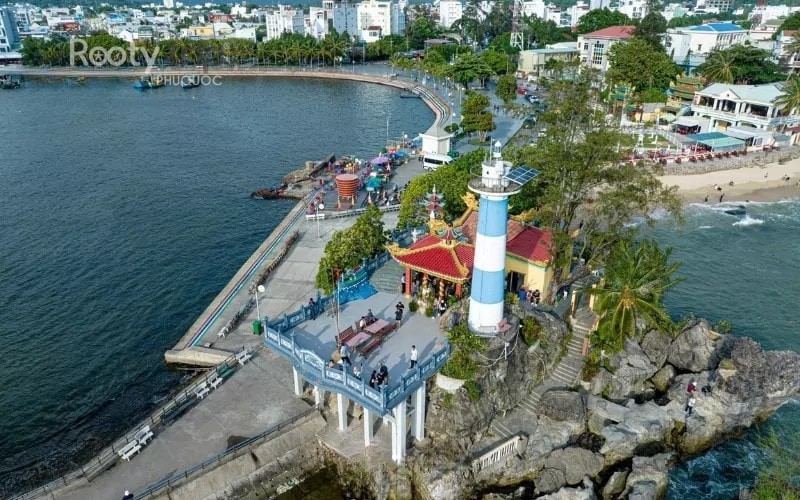
To reach Dinh Cau, visitors must climb 29 winding stone steps from the base of the cliff to the top, where the temple is perched. Though not a long climb, the path offers a sense of spiritual transition-like shedding the mundane world before arriving at a sacred place. The steps are built to follow the natural terrain, weaving through rocks and vegetation, adding to the charm of the journey.
Next to Dinh Cau is a small lighthouse, symbolizing guidance and protection. Its presence enhances the temple’s image as a “guardian of the sea.” Standing here, visitors can gaze out over the vast ocean and feel the harmony between humanity and nature.
Intricate carvings and curved roofs
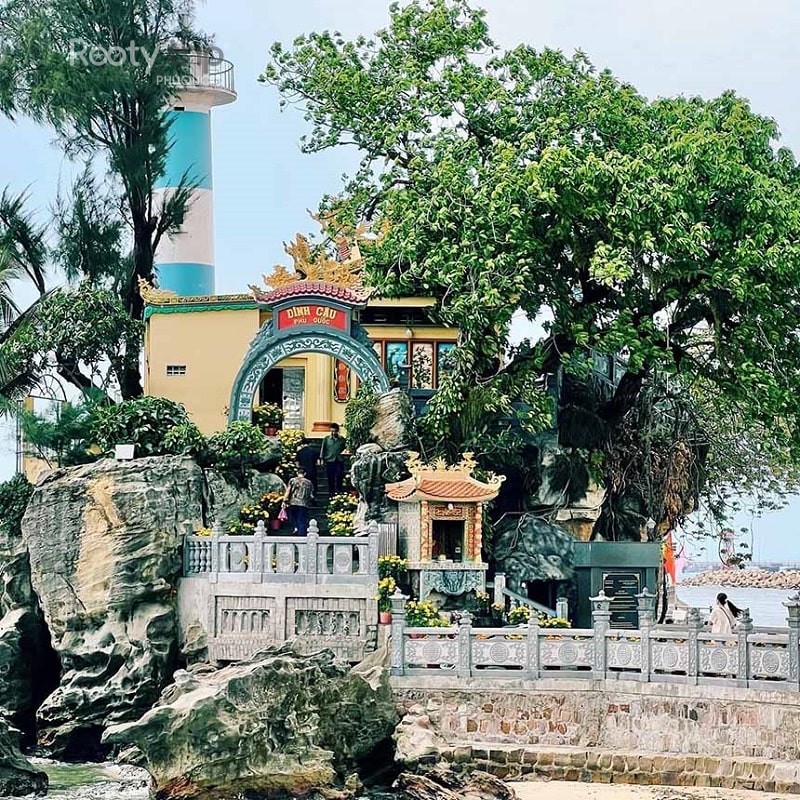
The architecture of Dinh Cau is distinguished by its curved tiled roofs, shaped like bird beaks-a classic element of traditional Vietnamese temples. The roof edges and door frames are adorned with carvings of dragons, phoenixes, and lotus flowers, symbolizing sacredness, nobility, and cosmic harmony. These flowing yet defined lines give the temple an elegant, artistic presence.
Additionally, the reliefs and deity statues are meticulously crafted, showcasing the skilled artistry of past generations. Despite multiple restorations over the years, Dinh Cau has retained its ancient charm, standing as a living testament to the enduring cultural identity of the people of Phu Quoc.
Looking for an adventure? Join a Phu Quoc snorkeling tour and dive into the island’s most beautiful marine spots.
Spiritual significance of Dinh Cau Temple
Worship of Thien Hau Thanh Mau, Cau Tai and Cau Quy
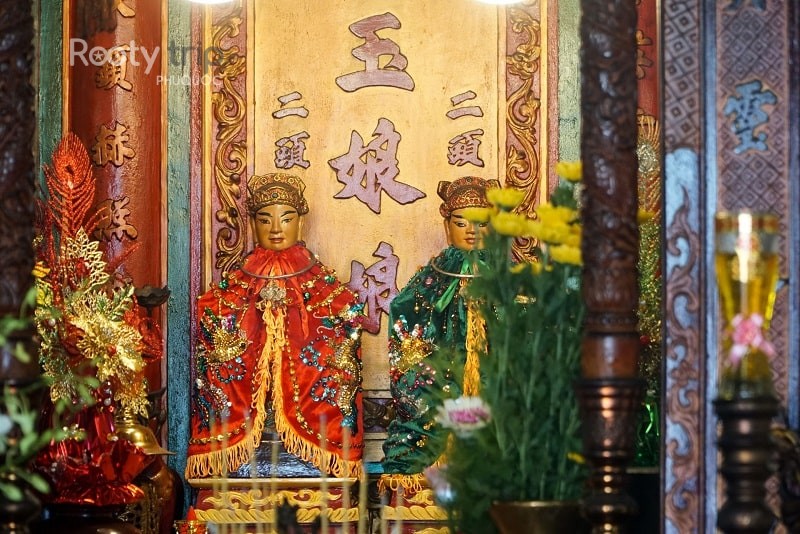
Dinh Cau Temple is dedicated to Thien Hau Thanh Mau, a revered sea goddess worshipped by coastal communities for her protection over fishermen on long voyages. Alongside her are two local guardian spirits, Cau Tai and Cau Quy, believed to have protected early settlers in Phu Quoc from natural disasters and pirates. Together, these deities form a spiritual trinity that brings peace of mind and a strong sense of belief to the island’s residents.
Though the worship of Thien Hau originates from Chinese culture, its integration with native Vietnamese beliefs at Dinh Cau creates a unique spiritual blend. This harmonious combination reflects the cultural openness and religious fusion of Phu Quoc’s islanders.
A place of prayer before setting sail
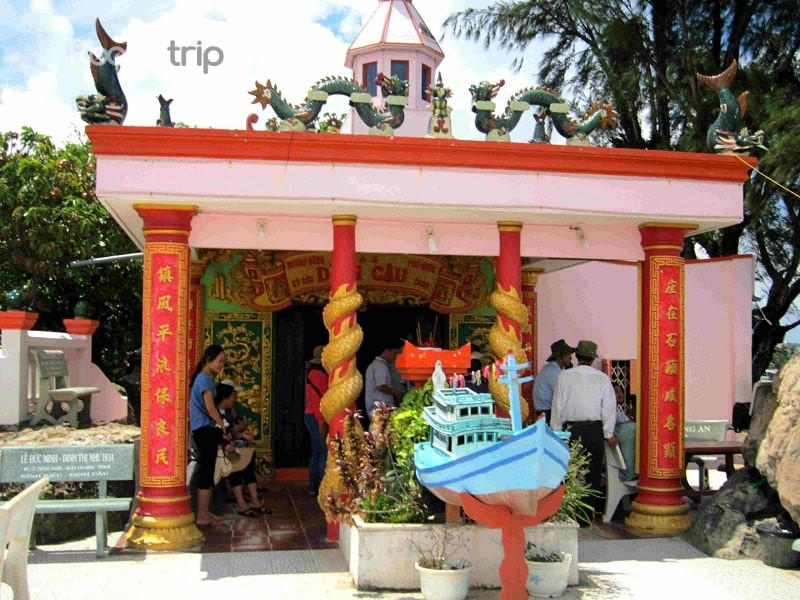
For generations, local fishermen have regarded Dinh Cau as a spiritual anchor. Before embarking on long sea journeys, they stop by the temple to burn incense and pray for safe travels and bountiful catches.
Over time, this custom has evolved from a ritual into a daily practice, deeply embedded in local life. On full moon days and the first day of each lunar month, the temple welcomes large crowds of worshippers and visitors, showcasing the community’s enduring reverence and devotion.
Daily offerings and ceremonies
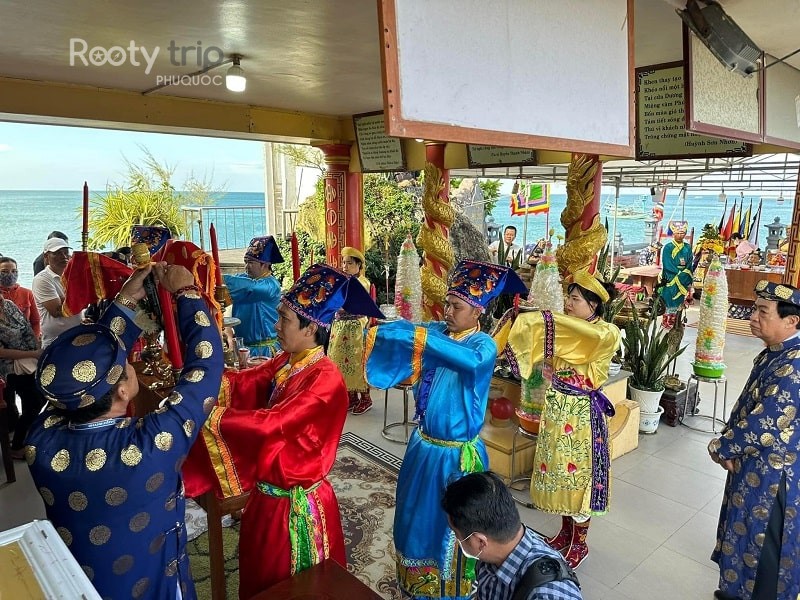
Besides major events like the Dinh Cau Festival in the 10th lunar month, the temple hosts regular daily and periodic rituals. Visitors can witness or participate in offerings such as incense burning, gift offerings, fortune sticks, and silent prayers, all held in a solemn yet approachable atmosphere.
The temple is maintained by village elders who ensure that traditional ceremonies are conducted properly and respectfully, preserving the spiritual essence of this sacred site. Dinh Cau is not only a tourist attraction but a living space for Vietnamese folk spirituality.
Dinh Cau Festival
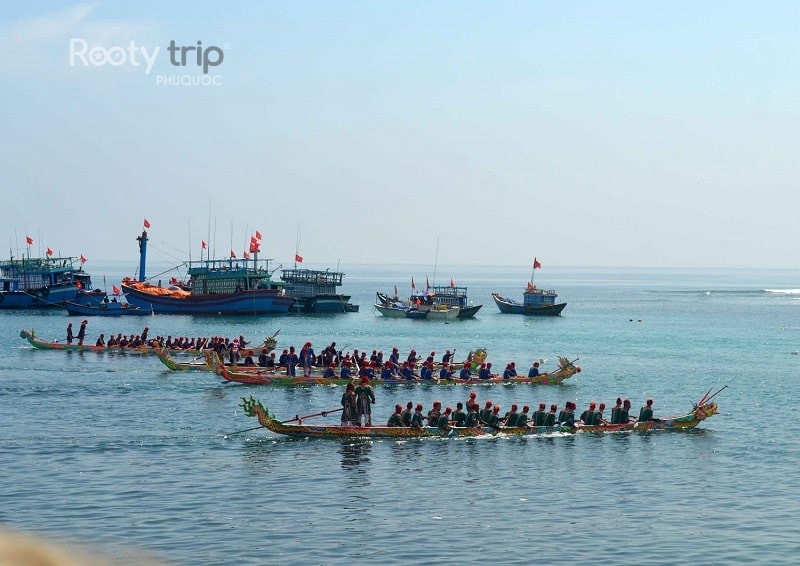
Held annually on the 15th-16th of the 10th lunar month
The Dinh Cau Festival is one of the most important cultural and spiritual events on Phu Quoc Island. Held annually on the 15th and 16th days of the 10th lunar month, it allows locals to express gratitude to the deities who protect the sea and pray for a prosperous and safe fishing year.
The festival is more than a religious occasion; it is a time for community bonding and the continuation of cultural traditions. Over two vibrant days, the festive spirit fills the air, drawing thousands of locals and tourists to join the celebrations.
Traditional activities: rituals, boat Racing, water puppetry, and classical opera
The festival opens with solemn ceremonial worship, including a deity procession, incense offerings, prayers, and reading of ceremonial texts. This segment reflects the community’s sincere devotion.
Following the rituals are a variety of cultural and folk performances:
- Boat Racing: Teams from local fishing villages compete on the Duong Dong River, drawing cheering crowds.
- Water Puppetry and Lion Dancing: Artistic interpretations of folk tales that honor the gods and entertain attendees.
- Classical Vietnamese Opera (Hat Boi): A traditional form of Southern stage art performed at night within the temple grounds.
These activities not only entertain but also serve as a medium for cultural preservation and education for younger generations.
A cultural magnet for locals and tourists
With its combination of spiritual depth, local tradition, and festive atmosphere, the Dinh Cau Festival is a highlight for both locals and tourists. In recent years, it has attracted thousands of visitors eager to immerse themselves in authentic Vietnamese culture.
The event also plays a key role in promoting spiritual tourism and showcasing Phu Quoc as a destination that is not only beautiful but also rich in cultural heritage.
Visiting Dinh Cau Temple
Best time to visit: November to March
The ideal time to visit Dinh Cau Temple is during the dry season from November to March, when the weather is cool and pleasant. This is also the best time to enjoy the island’s famous sunsets from the temple’s vantage point.
If you’re interested in experiencing traditional celebrations, visit during the Dinh Cau Festival in the 10th lunar month.
Dress vode and visitor etiquette
As a sacred place, Dinh Cau Temple requires visitors to:
- Dress modestly and respectfully (avoid sleeveless shirts, short skirts, and shorts).
- Maintain silence, avoid loud conversations or disruptive behavior.
- Burn incense only in designated areas and keep the environment clean.
- Refrain from taking photos at the altar without permission.
Getting there: taxi, motorbike, or tour packages
Located in central Duong Dong Town, Dinh Cau is very accessible:
- Taxi/Grab: Quick and convenient for families and small groups.
- Motorbike rental: Ideal for independent travelers (approx. 120,000–150,000 VND/day).
- Tour packages: Many travel companies offer tours that include Dinh Cau along with the night market and nearby attractions.
Nearby attractions
Phu Quoc Night Market
Just a few minutes’ walk from Dinh Cau, this bustling market is perfect for sampling fresh seafood and shopping for local specialties like pepper, sim wine, pearls, and souvenirs.
Dinh Ba Temple

Close to Dinh Cau is Dinh Ba Thuy Long Thanh Mau, a temple linked to the legend of the island’s founding mother. It’s another significant spiritual site that attracts both locals and tourists.
Duong Dong Beach and Seafood Stalls
After visiting Dinh Cau, relax on the nearby Duong Dong Beach, known for its soft sand and scenic sunset views. Numerous seafood eateries nearby offer local delicacies like grilled sea urchin, pickled herring salad, and steamed crab.
Travel tips Dinh Cau Temple Phu Quoc
Recommended hotels near Dinh Cau
Some top-rated accommodations include:
- Salinda Resort Phu Quoc – premium service, beachside location
- Cassia Cottage – rustic charm, peaceful atmosphere
- Phu Quoc Ocean Pearl Hotel – central location, reasonable rates
- M Hotel Phu Quoc – modern amenities and design
Guided tours and travel services
Opt for tours with local guides for deeper cultural insights. Combined tours featuring Dinh Cau, the night market, Ham Ninh fishing village, and fish sauce factories are popular choices.
Weather and cultural etiquette
- Bring sunblock, a hat, and water, especially during hot months.
- Do not litter or touch altars/statues.
- Respect the sacred space, keep noise levels down.
- Be mindful of other visitors and worshippers.
Dinh Cau Temple is not only a sacred icon of Phu Quoc Island but also a remarkable destination blending spirituality, heritage, and natural beauty. With its scenic location, ancient architecture, and rich history, the temple offers visitors a peaceful and meaningful experience.
If you’re planning a trip to Phu Quoc, don’t miss Dinh Cau – a spiritual gateway where the sea, culture, and soul of the island converge.






